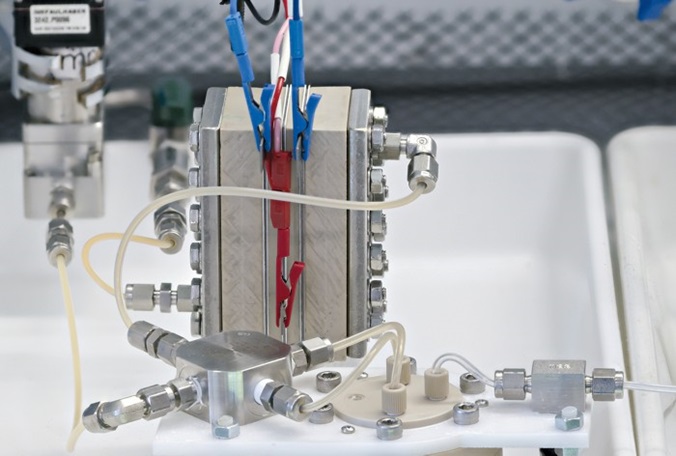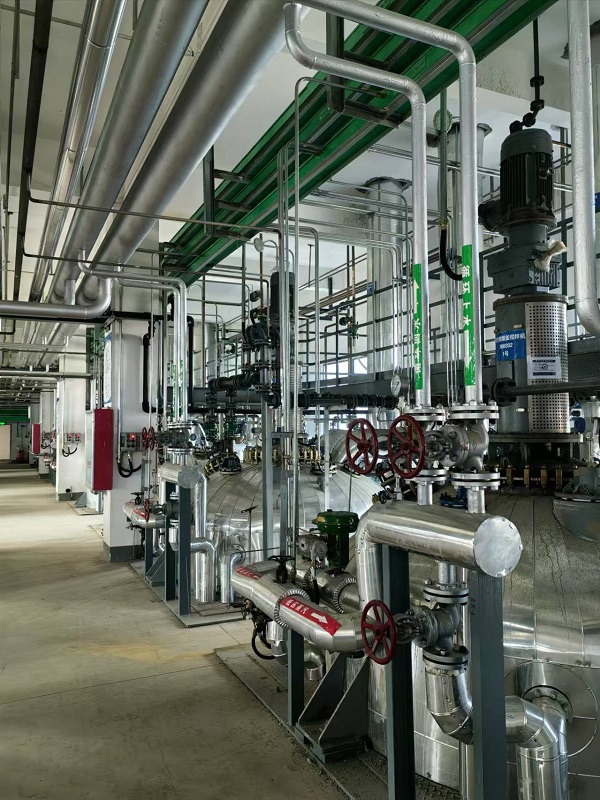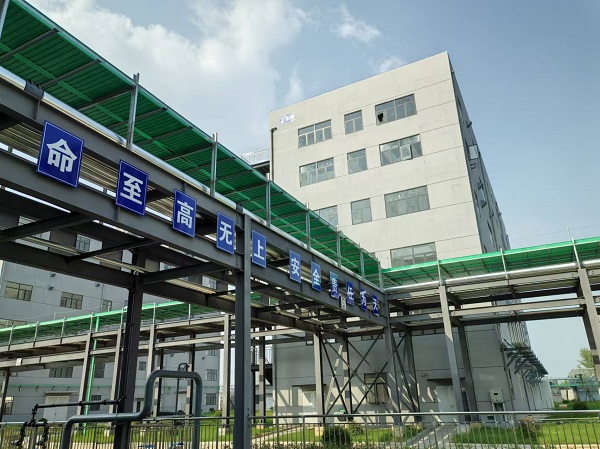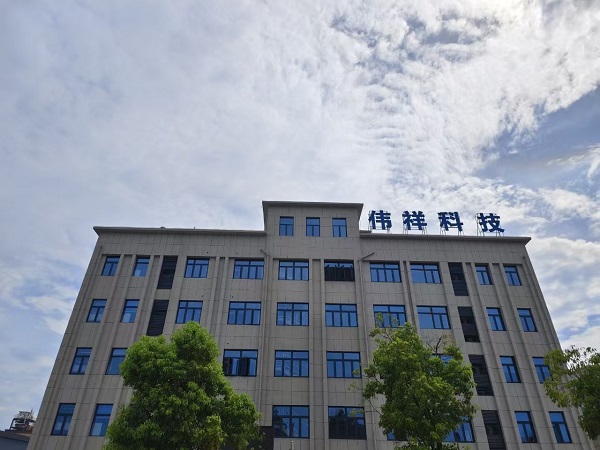- Inherent SafetyInherent Safety
- Efficient ReactionEfficient Reaction
- Green and Environmentally FriendlyGreen and Environmentally Friendly
- Low cost, High returnLow cost, High return
- Inherent SafetyInherent Safety
- Efficient ReactionEfficient Reaction
- Green and Environmentally FriendlyGreen and Environmentally Friendly
- Low cost, High returnLow cost, High return


Small volume: Microchannel reactors typically have smaller channel sizes, resulting in a smaller volume of reactants during the reaction process, and relatively less energy release, thereby reducing potential hazards. Rapid heat transfer: The channel structure of microchannel reactors can provide a large specific surface area, enabling rapid heat transfer, allowing reactants to dissipate heat quickly and avoid dangers caused by overheating. Optimized mixing effect: The channel structure of microchannel reactors can effectively achieve the mixing of reactants, thereby improving reaction efficiency, allowing reactants to mix more uniformly and reducing the dangers caused by excessively high local concentrations. Precise temperature control: Microchannel reactors can usually achieve precise temperature control through external heating or cooling systems, allowing the reaction temperature to be controlled within a safe range, avoiding dangers caused by excessively high or low temperatures.
Small volume: Microchannel reactors typically have smaller channel sizes, resulting in a smaller volume of reactants during the reaction process, and relatively less energy release, thereby reducing potential hazards. Rapid heat transfer: The channel structure of microchannel reactors can provide a large specific surface area, enabling rapid heat transfer, allowing reactants to dissipate heat quickly and avoid dangers caused by overheating. Optimized mixing effect: The channel structure of microchannel reactors can effectively achieve mixing of reactants, thereby improving reaction efficiency, allowing reactants to mix more uniformly and reducing the dangers caused by excessively high local concentrations. Precise temperature control: Microchannel reactors can usually achieve precise temperature control through external heating or cooling systems, allowing the reaction temperature to be controlled within a safe range, avoiding dangers caused by excessively high or low temperatures.
Low reactant dosage: Due to the small volume characteristics of the microchannel reactor, the amount of reactants used is relatively small, and during the reaction process, the amount of potential hazardous substances is also reduced, lowering the potential danger.
Low reactant dosage: Due to the small volume characteristics of the microchannel reactor, the amount of reactants used is relatively small, and during the reaction process, the amount of potential hazardous substances is also reduced, lowering the potential danger.


Small size: Microchannel reactors typically have smaller channel dimensions, which means the distance between reactants and catalysts is very short, facilitating rapid mass transfer and reaction occurrence. At the same time, the small size can also provide a large specific surface area, increasing the contact area between reactants and catalysts, thereby improving reaction efficiency. Rapid mass transfer: The channel structure of microchannel reactors can provide a large specific surface area, enabling rapid mass transfer. The flow velocity of reactants in the channels is relatively fast, effectively promoting mass transfer between reactants and catalysts, accelerating the reaction rate. Optimized mixing effect: The channel structure of microchannel reactors can effectively achieve mixing of reactants. Due to the small channel size and reasonable shape design, reactants can be mixed more uniformly, reducing local concentration differences and improving reaction efficiency. Precise temperature control: Microchannel reactors can usually achieve precise temperature control through external heating or cooling systems. This can maintain a constant temperature during the reaction process, improving the selectivity and yield of the reaction.
Small size: Microchannel reactors typically have smaller channel sizes, which means the distance between reactants and catalysts is very short, facilitating rapid mass transfer and reaction occurrence. At the same time, the small size can also provide a large specific surface area, increasing the contact area between reactants and catalysts, thereby improving reaction efficiency. Rapid mass transfer: The channel structure of microchannel reactors can provide a large specific surface area, enabling rapid mass transfer. The flow speed of reactants in the channels is relatively fast, effectively promoting mass transfer between reactants and catalysts, accelerating the reaction rate. Optimized mixing effect: The channel structure of microchannel reactors can effectively achieve mixing of reactants. Due to the small channel size and reasonable shape design, reactants can be mixed more uniformly, reducing local concentration differences and improving reaction efficiency. Precise temperature control: Microchannel reactors can usually achieve precise temperature control through external heating or cooling systems. This can maintain a constant temperature during the reaction process, improving the selectivity and yield of the reaction.
Low-quality thermal effect: Due to the small volume characteristics of the microchannel reactor, the volume of reactants is relatively small, and the energy release is also relatively low. This means that the heat generated during the reaction can dissipate more quickly, reducing the impact of the thermal effect on the reaction and improving the efficiency of the reaction.
Low-quality thermal effect: Due to the small volume characteristics of the microchannel reactor, the volume of reactants is relatively small, and the energy release is also relatively low. This means that the heat generated during the reaction process can dissipate more quickly, reducing the impact of the thermal effect on the reaction and improving the efficiency of the reaction.


Small reactant dosage: Due to the small volume characteristics of microchannel reactors, the amount of reactants used is relatively small. This means that the consumption of raw materials and catalysts required during the reaction process is reduced, minimizing resource waste. High reaction efficiency: The structure of microchannel reactors can provide a large specific surface area, accelerating the reaction rate and mass transfer, thereby improving reaction efficiency. This means that a higher product yield can be obtained in the same amount of time, reducing waste generation. Optimized mixing effect: The channel structure of microchannel reactors allows for rapid mixing of reactants, reducing local concentration differences. This means that reactants can be mixed more uniformly, improving the selectivity of the reaction and reducing the generation of by-products. Precise temperature control: Microchannel reactors can usually achieve precise temperature control, avoiding the adverse effects of excessively high or low temperatures on the reaction. This means that reactions can be carried out at lower temperatures, reducing energy consumption.
Small reactant dosage: Due to the small volume characteristics of microchannel reactors, the amount of reactants used is relatively small. This means that the consumption of raw materials and catalysts required during the reaction process is reduced, minimizing resource waste. High reaction efficiency: The structure of microchannel reactors can provide a large specific surface area, accelerating the reaction rate and mass transfer, thereby improving reaction efficiency. This means that a higher product yield can be obtained in the same amount of time, reducing waste generation. Optimized mixing effect: The channel structure of microchannel reactors allows for rapid mixing of reactants, reducing local concentration differences. This means that reactants can be mixed more uniformly, improving the selectivity of the reaction and reducing the generation of by-products. Precise temperature control: Microchannel reactors can typically achieve precise temperature control, avoiding the adverse effects of excessively high or low temperatures on the reaction. This means that reactions can be carried out at lower temperatures, reducing energy consumption.
Reduce waste emissions: Due to the high reaction efficiency and optimized mixing effect of microchannel reactors, the amount of waste generated is reduced. This means less pollution to the environment, in line with the principles of green chemistry.
Reduce waste emissions: Due to the high reaction efficiency and optimized mixing effect of microchannel reactors, the amount of waste generated is reduced. This means less pollution to the environment, in line with the principles of green chemistry.


Small volume design: Microchannel reactors have a smaller volume compared to traditional reactors, which means savings in construction and operating costs. High mass transfer efficiency: The channel structure of microchannel reactors provides a large specific surface area, accelerating the mass transfer rate between reactants and catalysts. This means that higher product yields can be obtained in the same time, improving returns. High mass transfer efficiency can also reduce the residence time of reactants in the channels, lowering the generation of side reactions and by-products, further enhancing returns. High reaction efficiency: Due to the optimized mixing effects and rapid mass transfer characteristics of microchannel reactors, reactants can be mixed more uniformly and react quickly, improving reaction efficiency. This means that more products can be obtained with the same time and resource input, increasing returns. High reaction efficiency can also reduce waste generation, lowering treatment and disposal costs.
Compact design: Microchannel reactors have a smaller volume compared to traditional reactors, which means savings in construction and operating costs. High mass transfer efficiency: The channel structure of microchannel reactors provides a large specific surface area, accelerating the mass transfer rate between reactants and catalysts. This means that higher product yields can be obtained in the same time, improving returns. High mass transfer efficiency can also reduce the residence time of reactants in the channels, decreasing the generation of side reactions and by-products, further enhancing returns. High reaction efficiency: Due to the optimized mixing effects and rapid mass transfer characteristics of microchannel reactors, reactants can be mixed more uniformly and react quickly, improving reaction efficiency. This means that more products can be obtained with the same time and resource input, increasing returns. High reaction efficiency can also reduce waste generation, lowering treatment and disposal costs.
Accurate temperature control: Microchannel reactors typically have precise temperature control capabilities, allowing for a constant reaction temperature. This helps to improve the selectivity and yield of the reaction, reduces the generation of by-products, and increases the yield.
Accurate temperature control: Microchannel reactors typically have precise temperature control capabilities, allowing for a constant reaction temperature. This helps to improve the selectivity and yield of the reaction, reduces the generation of by-products, and increases the profit.
The Chizhou factory is located in the Chizhou Economic Development Zone, 60 kilometers away from the Tongling factory, with a workshop area of 2500 square meters, equipped with modern factory facilities and advanced equipment. We have pilot reaction kettles of 100L, 500L, and 2000L, as well as supporting auxiliary and testing equipment. This enables us to provide small-scale and pilot-scale experimental services.
Our team consists of experienced professionals with a solid foundation in chemical engineering knowledge and technical strength. We are committed to providing high-quality experiments and solutions for our clients...
The Chizhou factory is located in the Chizhou Economic Development Zone, 60 kilometers from the Tongling factory, with a workshop area of 2500 square meters, equipped with modern factory facilities and advanced equipment. We have 100L, 500L, and 2000L pilot reaction kettles, as well as supporting auxiliary and testing equipment. This enables us to provide small-scale and pilot-scale experimental services.
Our team consists of experienced professionals with profound chemical knowledge and technical strength. We are committed to providing high-quality experiments and solutions for our clients...


The Tongling factory is located in the eastern chemical park of the national-level Tongling Economic and Technological Development Zone, 60 kilometers away from the Chizhou factory. It is a high-tech enterprise focused on the research and development, production, and sales of alkane series products, prostaglandin series products, and high-purity display material series products. The company is also committed to the construction and operation of a new pharmaceutical shared pilot platform, aiming to promote innovative development in the pharmaceutical industry. Project investment and scale.
The Tongling factory is located in the eastern chemical park of the national-level Tongling Economic and Technological Development Zone, 60 kilometers away from the Chizhou factory. It is a high-tech enterprise focused on the research and development, production, and sales of alkane series products, prostaglandin series products, and high-purity display material series products. The company is also committed to the construction and operation of a new pharmaceutical shared pilot platform, aiming to promote innovative development in the pharmaceutical industry. Project investment and scale.
The total investment of the project reaches 300 million RMB. The company covers an area of 31,750....
The total investment of the project reaches 300 million RMB. The company covers an area of 31,750....








Communicate with clients to understand their needs and project requirements, provide relevant technical consultation and answer questions.
Communicate with clients to understand their needs and project requirements, provide relevant technical consulting and answer questions.
STEP1
STEP1
Ensure the confidentiality and security of project information, establish a cooperation framework and legal protection for both parties.
Ensure the confidentiality and security of project information, establish a cooperation framework and legal protection for both parties.
STEP2
STEP2
Collect the process data and requirements provided by the customer, conduct process handover and analysis, and provide a basis for subsequent verification and design.
Collect the process data and requirements provided by the customer, conduct process handover and analysis, and provide a basis for subsequent verification and design.
STEP3
STEP3
Preliminary validation of microchannel reactors in a small-scale laboratory environment, assessing reaction effects and feasibility
Preliminary validation of microchannel reactors in a small-scale laboratory environment, assessing reaction effects and feasibility
STEP4
STEP4
Further validation of microchannel reactors in pilot laboratories or experimental devices, optimizing process parameters and conditions
Further validation of microchannel reactors in pilot laboratories or experimental devices, optimizing process parameters and conditions
STEP5
STEP5
According to the verification results and customer requirements, carry out the equipment research and development and design of the microchannel reactor, including structure, materials, and control systems, etc.
According to the verification results and customer requirements, carry out the equipment research and development and design of the microchannel reactor, including structure, materials, and control systems, etc.
STEP6
STEP6
Debugging and optimizing the microchannel reactor for research and design to ensure the normal operation and stability of the equipment.
Debugging and optimizing the microchannel reactor for R&D design to ensure the normal operation and stability of the equipment.
STEP7
STEP7
After the equipment manufacturing is completed, conduct factory acceptance to ensure that the equipment meets specifications and requirements, and prepare for delivery to the customer.
After the equipment manufacturing is completed, conduct factory acceptance to ensure that the equipment meets specifications and requirements, and prepare for delivery to the customer.
STEP8
STEP8
Page 2
Page 2
Page 3
Page 3
The Chizhou factory is located in the Chizhou Economic Development Zone, 60 kilometers from the Tongling factory, with a workshop area of 2500 square meters, equipped with modern factory facilities and advanced equipment. We have 100L, 500L, and 2000L pilot reaction kettles, as well as supporting auxiliary and testing equipment. This enables us to provide small-scale and pilot-scale experimental services. Our team consists of experienced professionals with a strong background in chemical engineering knowledge and technical strength. We are committed to providing high-quality experiments and solutions to meet the needs of different projects. Whether for small-scale verification or pilot experiments, we can perform precise operations and analyses based on customer requirements and process data. We focus on the feasibility of experiments and effect evaluation to ensure that customers can obtain accurate data and reliable results.
The Chizhou factory is located in the Chizhou Economic Development Zone, 60 kilometers from the Tongling factory, with a workshop area of 2500 square meters, equipped with modern factory facilities and advanced equipment. We have 100L, 500L, and 2000L pilot reaction kettles, as well as supporting auxiliary and testing equipment. This enables us to provide small-scale and pilot-scale experimental services. Our team consists of experienced professionals with a strong background in chemical engineering knowledge and technical strength. We are committed to providing high-quality experiments and solutions to meet the needs of different projects. Whether for small-scale verification or pilot-scale experiments, we can perform precise operations and analyses based on customer requirements and process data. We focus on the feasibility of experiments and effect evaluation to ensure that customers can obtain accurate data and reliable results.
We always adhere to the principle of quality first and customer foremost, providing customers with high-quality services and satisfactory solutions. If you have any needs for small-scale or pilot-scale chemical trials, please feel free to contact us, and we will sincerely provide you with professional support and services.
We always adhere to the principle of quality first and customer foremost, providing customers with high-quality services and satisfactory solutions. If you have any needs for small-scale or pilot-scale chemical trials, please feel free to contact us, and we will wholeheartedly provide you with professional support and services.
Page 4
Page 4
The Tongling factory is located in the eastern chemical park of the national-level Tongling Economic and Technological Development Zone, 60 kilometers away from the Chizhou factory. It is a high-tech enterprise focused on the research and development, production, and sales of alkane series products, prostaglandin series products, and high-purity display material series products. The company is also committed to the construction and operation of a new pharmaceutical shared pilot platform, aiming to promote innovative development in the pharmaceutical industry.
The Tongling factory is located in the eastern chemical park of the national-level Tongling Economic and Technological Development Zone, 60 kilometers away from the Chizhou factory. It is a high-tech enterprise focused on the research and development, production, and sales of aliphatic series products, prostaglandin series products, and high-purity display material series products. The company is also committed to the construction and operation of a new pharmaceutical shared pilot platform, aiming to promote innovative development in the pharmaceutical industry.
Project Investment and Scale
Project Investment and Scale
The total investment of the project reaches 300 million RMB. The company covers an area of 31,750.95 square meters, with a planned construction area of 18,671.24 square meters, and has a series of modern infrastructure including a comprehensive building (R&D building), central control room, power center, as well as Class A, Class B, Class C warehouses and various workshops.
The total investment of the project reaches 300 million RMB. The company covers an area of 31,750.95 square meters, with a planned construction area of 18,671.24 square meters, and has a series of modern infrastructure including a comprehensive building (R&D building), central control room, power center, as well as Class A, Class B, Class C warehouses and various workshops.
Production Capacity and Equipment
Production Capacity and Equipment
The company has purchased multiple sets of advanced production equipment, including glass reactors, enamel glass reactors, special steel reactors, synthesis towers, and high-efficiency distillation towers, ensuring high efficiency in the production process and high standards of product quality. The overall project planning and design, as well as the infrastructure, were completed in one go, with the products being launched in three phases.
The company has purchased multiple sets of advanced production equipment, including glass reactors, glass-lined reactors, special steel reactors, synthesis towers, and high-efficiency distillation towers, ensuring high efficiency in the production process and high standards of product quality. The overall project planning and design, as well as the infrastructure, were completed in one go, with the products being launched in three phases.

